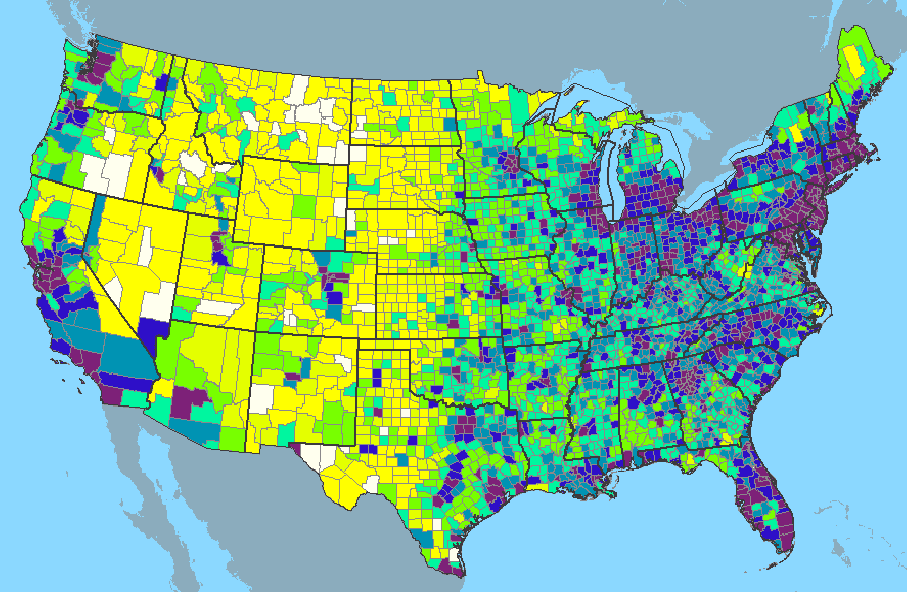Proposed Legislation Reflects Industrial Siting Concerns
The question of “where?” has many implications.
In December, a plastics bill (S5163) was introduced containing many provisions that by now may sound familiar from other proposed or passed legislation in individual states or in other countries. Along with a reduction for single use plastic, bottle redemption, pollution monitoring requirements, and funding programs for studying the health effects of plastics, there is a ban on the permitting of plastic production facilities within five miles of a home, school, or other community center. It sounds like a long way, but like most people my time is clustered around areas full of such sites. Certainly there are parts of the country that are less populated or even unpopulated.

Population of U.S. Counties in the Contiguous 48. Counties in white <1 per sq. mile.
Photo Credit: National Atlas of the United States, Public Domain
Practical considerations around the specific measure aside, the spirit of the provision comes from the idea that historically, project siting has followed paths of least resistance rather than a strategy to minimize impact. And of course this is related to a broader concept that includes everything from interstates to soccer stadiums, which have been sited with or without the onboarding of fence line communities.
Some have suggested the focus on cataclysmic, global environmental impacts may obscure community-scale issues. In her acerbic 2021 book Stop Saving the Planet, Jenny Price critiques the direction of the environmental movement for its enthusiasm for buying new green products, and lackluster engagement with communities impacted directly by acute hazards such as local spills. Her key message: an opportunity lies in listening to communities.
It’s natural to fear the less likely, more dramatic risks. Many tools for understanding the environment enshrine the focus on the global, the cataclysmic. Consider the planetary boundaries framework, proposed in 2009. It sets limits on nine quantifiable impacts of human activity, beyond which the environment would change too rapidly for human society to cope. It is useful for thinking about averting the doomsday scale stuff, but does not capture how impacts are distributed, how sub-threshold impacts might be fatal in one location and invisible in another. My cousin in Nevada may think about fresh water use differently than I do in Ohio.

The planetary boundaries framework. Orange areas indicate boundaries that are estimated to have been exceeded.
Credit: J. Lokrantz/Azote based on Steffen et al. 2015. (CC by 4.0)
Whether or not this piece of legislation goes anywhere near a vote, the idea of people living in an area having a say in things will likely persist. If discrepancies in political agency decline, as the macro trend seems to be, effective outreach programs are likely to be increasingly important to keep communities informed and, just as importantly, heard.
Related Content
-
Inside the Florida Recycler Taking on NPE’s 100% Scrap Reuse Goal
Hundreds of tons of demonstration products will be created this week. Commercial Plastics Recycling is striving to recycle ALL of it.
-
PHA Compound Molded into “World’s First” Biodegradable Bottle Closures
Beyond Plastic and partners have created a certified biodegradable PHA compound that can be injection molded into 38-mm closures in a sub 6-second cycle from a multicavity hot runner tool.
-
Processing Megatrends Drive New Product Developments at NPE2024
It’s all about sustainability and the circular economy, and it will be on display in Orlando across all the major processes. But there will be plenty to see in automation, AI and machine learning as well.
















